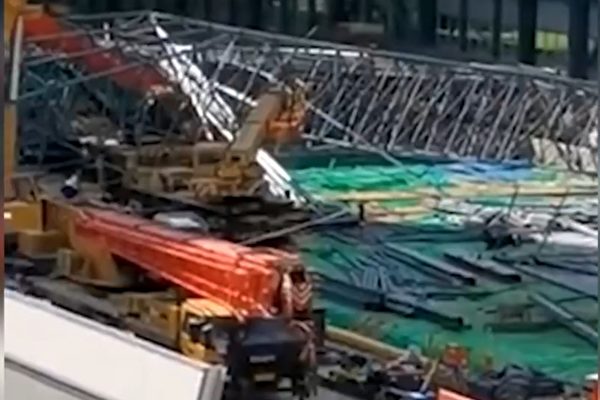In the first three quarters of this year, the combined net profit attributable to the parent companies of China’s nine central enterprises in the construction industry decreased by 10.86% year-on-year. Except for China Chemical, the other eight construction central enterprises all experienced declines, with China MCC showing a significant 41.9% drop. Of particular note is that in terms of the crucial net cash flow, China State Construction Engineering, China Railway Construction, China State Construction, and China Communications Construction all exceeded negative 60 billion yuan.
According to a research report by Huayuan Securities on November 19, in the first three quarters of 2025, the net profit attributable to the parent companies of the nine major construction central enterprises, except for China Chemical, all declined. Among them, both China MCC and China National Nuclear Corporation saw significant declines in their net profits.
China MCC recorded a revenue of 335.09 billion yuan in the first three quarters, a year-on-year decrease of 18.8%; the net profit attributable to the parent company was 3.97 billion yuan, down 41.9% year-on-year; and the non-recurring net profit was 3.05 billion yuan, a decrease of 45.7% year-on-year.
China National Nuclear Corporation achieved an operating income of 73.938 billion yuan in the first three quarters, a year-on-year decrease of 6.32%; the net profit attributable to the parent company was 1.106 billion yuan, down 23.96% year-on-year; and the non-recurring net profit was 1.082 billion yuan, a decrease of 28.82% year-on-year.
The nine major construction central enterprises refer to China State Construction Engineering, China Chemical, China Railway Construction, China State Construction, China Communications Construction, China Energy Engineering, China Metallurgical Group Corporation, and China National Nuclear Corporation.
Report from “My Steel Net” stated that in the first three quarters, the combined operating income of the nine major construction central enterprises was 4.884 trillion yuan, a 3.98% decrease year-on-year; the total net profit attributable to the parent companies was 104.068 billion yuan, a 10.86% decrease year-on-year.
Regarding the net profit decline of over 40%, China MCC mentioned in its third-quarter report that it was impacted by external factors such as the continuous decline in steel industry demand, weak growth in the construction industry, and significant adjustments in the real estate industry. Additionally, the company’s own transformation and upgrading led to structural adjustments in its business, resulting in a decrease in the amount of incomplete contracts carried over from the previous year and newly signed contracts, causing a reduction in the total profit along with a decrease in revenue scale, thus leading to a decline in the net profit attributable to the shareholders of the listed company.
The construction industry has always been a capital-intensive, high-turnover, low-profit sector. Compared to slowing revenue growth and declining profitability, the operational cash flow situation of construction companies is more closely watched by the market.
As of the end of the third quarter this year, China State Construction Engineering had the highest net cash outflow at -79.757 billion yuan, followed by China Railway Construction, China State Construction, and China Communications Construction, with net cash outflows of -72.883 billion yuan, -69.479 billion yuan, and -65.79 billion yuan respectively.
Net cash flow refers to the difference between the inflow and outflow of an enterprise’s cash and cash equivalents over a certain period, reflecting the net increase or decrease in the company’s cash flow. This value can be obtained by summing up the net cash flows from operating, investing, and financing activities.
Moreover, the combined revenue and net profit attributable to the parent companies of the nine major construction central enterprises accounted for 83.45% and 83.99% of the Shenwan construction sector, respectively. In the first three quarters, the revenue and net profit of this sector decreased by 5.51% and 10.06% respectively, indicating that the entire construction industry is facing a downturn and entering a contraction phase.
The Shenwan sector classifies the A-share market into 28 primary industries, covering mining, chemical industry, steel, non-ferrous metals, construction materials, architectural decoration, etc., with each primary industry further subdivided into secondary industries, totaling 104 categories.
With declining performance, layoffs, pay cuts, and delayed payments of project funds have frequently occurred in central enterprises and state-owned enterprises in the construction industry this year. In June, employees of China Railway Shanghai Engineering Bureau received a notice that changed their income structure. A document issued by the Human Resources Department explicitly announced the suspension of performance-based compensation and rewards for all employees, retaining only basic salaries and related allowances.
According to a September report by Dajiyuan, several bloggers disclosed that Shanghai Construction Group is preparing to lay off a large number of employees before the end of the year, reducing the current workforce from 14,000 to fewer than 8,000. It is said that the layoffs will be carried out in batches, with some employees being let go as soon as projects are completed. Some employees are being sent home with only the minimum monthly wage of 2,690 yuan.

